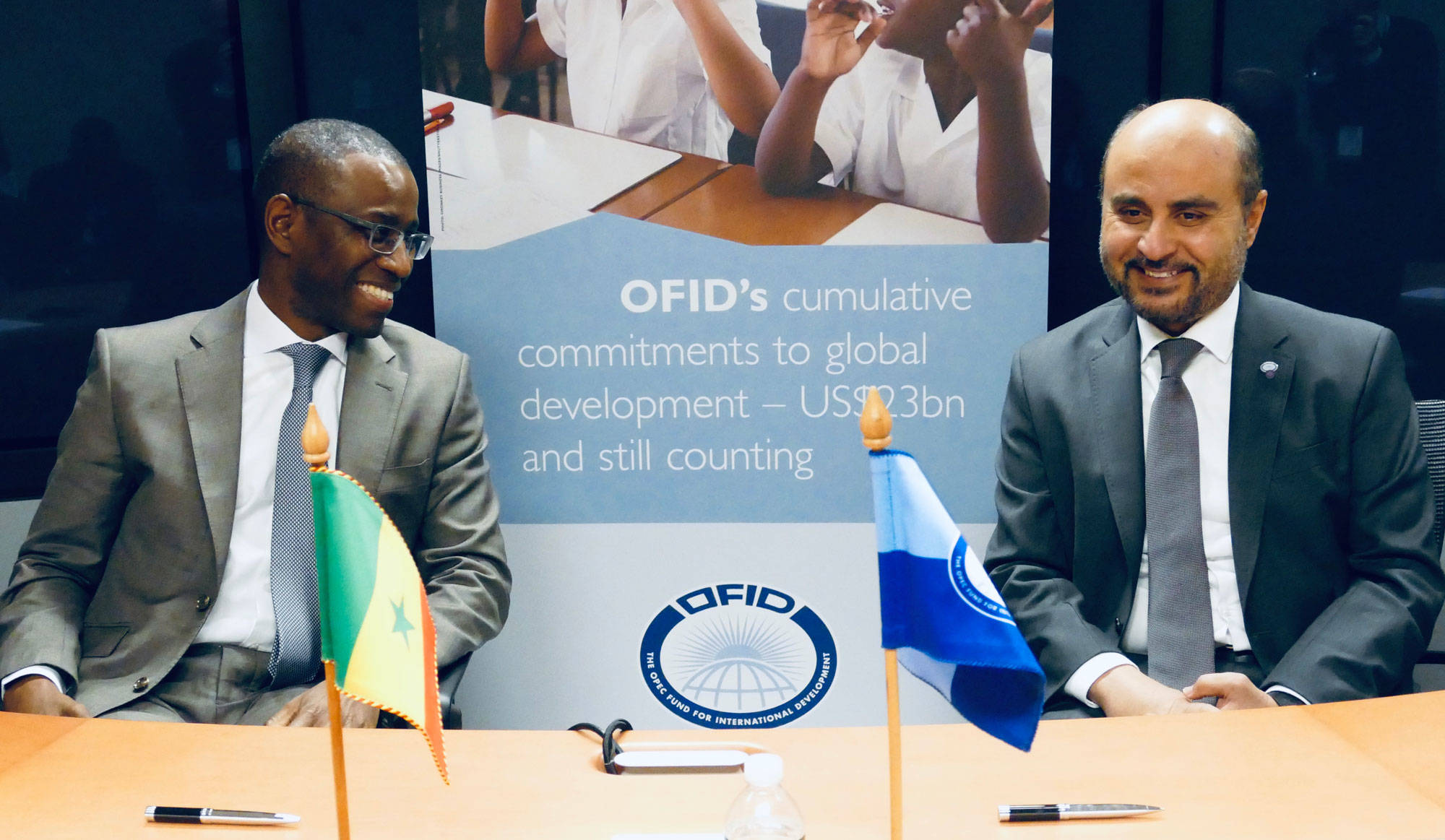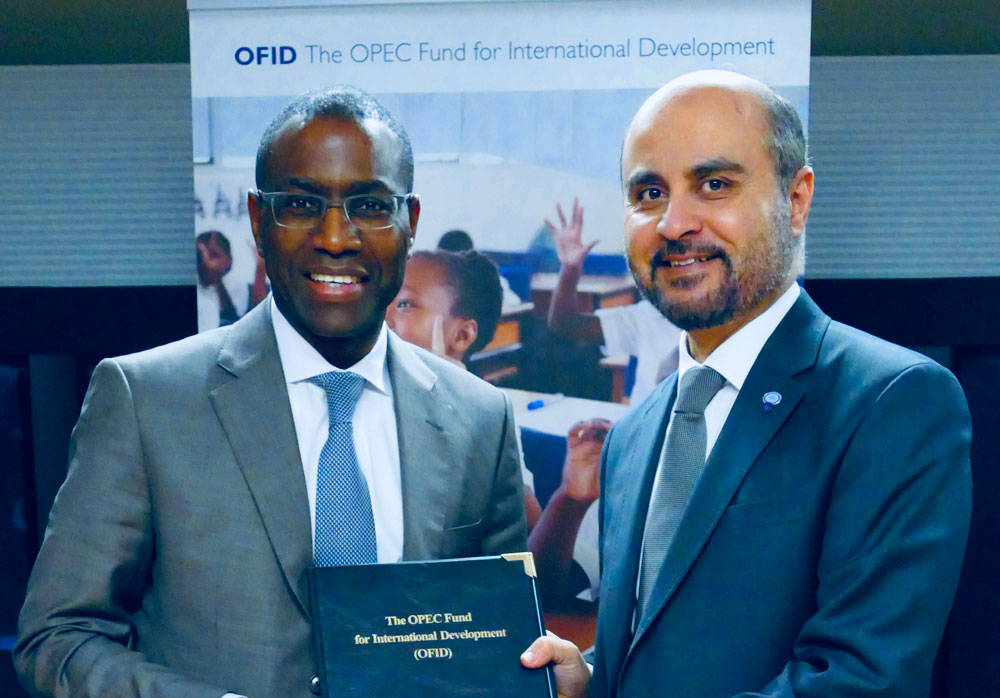We use Cookies. Read our Terms
- News
- Senegal: Jobs, sustainability and sources of growth
Senegal: Jobs, sustainability and sources of growth
An interview with Amadou Hott, Senegal's Minister of Economy, Planning and Cooperation
As published in the 01/2020 issue of the OPEC Fund Quarterly

OPEC Fund’s Director-General Dr Abdulhamid Alkhalifa (right) signed two loans with Senegal’s Minister of Economy, Planning and Cooperation Amadou Hott.
Here, we hear what the minister has planned for his country and where he would like to see Senegal in five years.
OPEC Fund Quarterly: Please briefly outline Senegal’s main development priorities.
Amadou Hott: Since 2014, the government of Senegal has implemented the Plan Senegal Emergent (PSE) in order to achieve emergence by 2035. Under the President of the Republic Macky Sall, Senegal has achieved a historically dynamic economic expansion while improving the welfare of the population.
Today, productivity gains, a determining factor in the process of structural transformation, are improving markedly, which the government is seeking to consolidate to form the basis of a resilient and inclusive economy.
For the second phase of the PSE, the main development priorities are: (i) eradicating poverty and reducing inequality in all its forms; (ii) infrastructure catch-up; (iii) improving central, decentralized and local governance; (iv) the gradual reduction of the informal sector; (v) the development of human capital and the capture of the demographic dividend.
OFQ: How important are relationships with development actors such as the OPEC Fund to progress in Senegal?
AH: The aim of the PSE II (2019-23) is to increase transformative public and private investment. With financing needs of 14,098 billion CFA francs (US$24.2 billion) for the PSE II, establishing a credible partnership and effective cooperation with donors will be key to successfully implementing our priority projects and programs, including for industrialization, economic diversification, social inclusion and sustainable development.
There are areas where the OPEC Fund’s support could be key, such as financial support to accelerate the mobilization of resources to transform our agriculture sector, promote industrial parks, invest in infrastructure projects and expand the logistics base; and support for the development of SMEs to create jobs (see below for more detail) and achieve higher and more inclusive growth.
OFQ: Please outline the role of the public and private sectors in supporting the socioeconomic development of Senegal.
AH: Strong economic growth, combined with the implementation of social programs, have led to a significant reduction in the incidence of poverty, estimated at 35.6 percent in 2017. This is below the average for sub-Saharan Africa and compares to 46.7 percent in 2011.
Examples of our social programs are as follows:
• Universal Health Coverage (Couverture Maladie Universelle, CMU);
• the National Family Security Scholarship Program (Bourse Nationale de Sécurité Familiale, BNSF);
• the Emergency Program for the Development of Secondary and Border Towns (Programme d’Urgence de Modernisation des Axes et Territoires Frontaliers, PUMA);
• the Community Development Emergency Program (Programme d’Urgence de Développement Communautaire, PUDC):
• and programs to support women's empowerment, job creation for young people and investments in the agriculture sector.
However, the government is aware that the large-scale creation of viable private jobs is the best way to promote wellbeing for all and to break the intergenerational transmission of poverty. In this regard, the government alone cannot mobilize the necessary resources without risk for macroeconomic stability. In addition to efforts to increase domestic revenues, there is a need to ensure effective private sector participation in development financing.
To do this, the government will focus on public-private partnerships and innovative financing instruments. Government efforts are underway to support a systematic technical and financial structuring of projects, with a view to facilitating ownership by the private sector.
The government is also accelerating reforms to increase access to finance and improve the business environment, expand the productive base of the economy, increase internal resources without harming productive investment, and support people's participation in development actions to strengthen the social contract.
With average economic growth expected to exceed 8 percent over the medium term, we expect to create at least 200,000 jobs a year.”
OFQ: Senegal’s economic growth has been strong in recent years – and agricultural progress has been a key driver. To what do you attribute this?
AH: The economy has remained on a new growth trajectory, never seen in the past, placing Senegal among the fastest growing countries in sub-Saharan Africa. Indeed, the growth rate more than doubled during the first phase of the PSE implementation, from an annual average of 3.0 percent over the period 2009-2013 to 6.6 percent over the period 2014-2018. Growth was driven by consumption and transformative investment, but also by the strengthening of exports.
Improved fiscal room for manoeuver, through the reduction of the fiscal deficit, has enabled the government to better support economic activity, and to cushion the effects of headwinds, (especially those related to the global environment). In the non-tradable goods sectors, we have mainly seen favorable developments in the construction and transport sectors, and improved energy supply. On the export side, the revival of traditional sectors (chemistry, fish products, tourism, etc.) combined with the boom in exports of horticultural products, have improved the economy.
The Senegalese Agricultural Accelerator Program (Programme d’Accélération de la Cadence de l’Agriculture Sénégalaise, PRACAS), the first phase of which has just been completed, has supported agricultural production and increased yields. Rice, the main consumer product, has seen its production grow rapidly, bringing us closer to self-sufficiency.
OFQ: Where do you expect to see Senegal in five years from a development / poverty reduction perspective?
AH: Looking ahead to 2020-2024, the average growth rate is projected at more than 8 percent in the context of oil and gas production from 2022. We anticipate a broadening of the sources for growth, with the development of the agricultural sector benefiting the agri-food industry. The ripple effects of oil and gas production will be felt on the financial sector and insurance sectors, among others. Rail transport will benefit from the entry into service of the first electric train in the sub-region and the restart of traffic in Mali.
Tourism is expected to revive as new areas are developed. With average economic growth expected to exceed 8 percent over the medium-term, we expect to create at least 200,000 jobs a year and the Human Development Index (HDI) would rise from 0.51 in 2017 to 0.53 in 2023. The incidence of monetary poverty is expected to fall by more than 4 percentage points to 36.9% in 2023.
To support the structural transformation of the economy, we will need to pursue structural reforms in education and vocational training. Social investments will be directed toward addressing people's needs, including improving nutrition and health, promoting social housing, strengthening social protection for workers and reducing social and territorial inequalities.
Please note this is an edited version of an email interview.
New loans signed
At the 2019 Annual Meetings of the World Bank and the International Monetary Fund, the OPEC Fund’s Director-General Dr Abdulhamid Alkhalifa signed two loans with Senegal’s Minister of Economy, Planning and Cooperation Amadou Hott:

US$10 million to support the Agricultural Development and Rural Entrepreneurship Program – Phase II (PADAER II). This program will construct infrastructure for small producers to increase yields and create more jobs, with a focus on women and youth.
US$20 million to support the Development of Agricultural Production Areas (PDZP/PNDL). To raise yields, reduce post-harvest losses and facilitate farmers’ access to inputs by developing agricultural value chains and capacity building. Also planned is the upgrading of 550 km of rural access roads.
Since 1976, not including the above, the OPEC Fund has approved 32 Public Sector loans to Senegal totaling more than US$223 million, as well as supporting the country under its Private Sector and Trade Finance lending window. Senegal has also benefited from a number of regional and national grants. Supported sectors include agriculture, education, health, industry, transportation and water and sanitation.